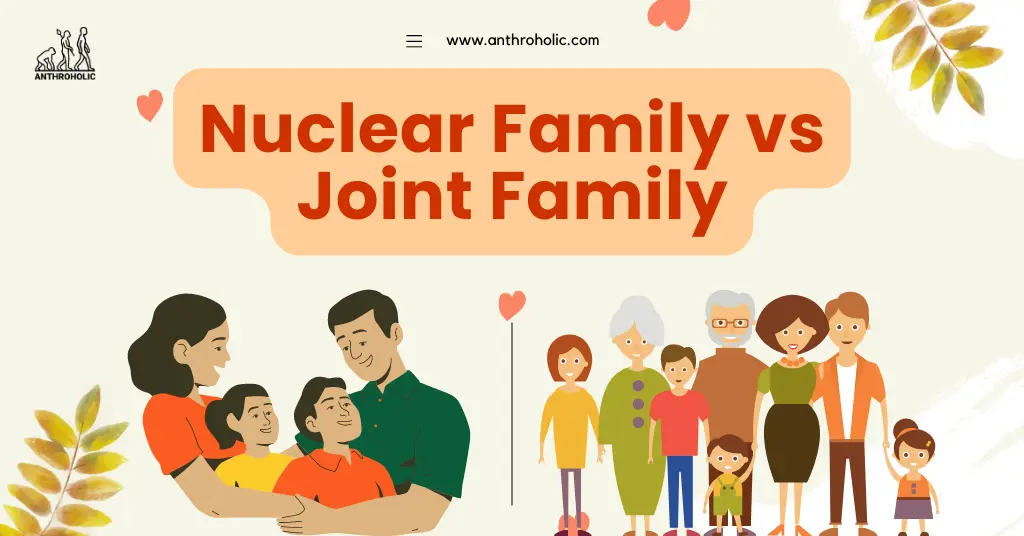AI Answer Evaluation Platform Live Now. Try Free Answer Evaluation Now
Nuclear Family and Joint Family
A family forms the first line of socialization for an individual and plays a pivotal role in shaping their perspective and behavior. The two primary types of family structures worldwide are nuclear family and joint family. A nuclear family typically includes parents and their offspring, while a joint family is an extended kinship network consisting of grandparents, uncles, aunts, and cousins.

Definition
Nuclear Family
A nuclear family, also referred to as an elementary family, consists of two parents and their children, all living under one roof [1]. It is considered the basic unit in many societies.
Joint Family
A joint family, or an extended family, is a large family unit that includes three or more generations living together. It includes the parents, their children, and other relatives such as grandparents, uncles, aunts, and cousins [2].
Comparison Between Nuclear and Joint Family
Advantages and Disadvantages of a Nuclear Family
Advantages
- Autonomy: Nuclear families provide a high degree of independence and freedom to make decisions [3].
- Financial Management: It is simpler to manage expenses and savings as there are fewer family members involved.
- Less Conflict: There may be fewer conflicts and disagreements as fewer people live together.
Disadvantages
- Lack of Support: In a nuclear family, parents often need to manage work and childcare simultaneously, which can be stressful.
- Lack of Shared Responsibility: With fewer adults in the household, responsibilities cannot be distributed as evenly as in joint families.
| Advantages | Disadvantages |
|---|---|
| Autonomy | Lack of Support |
| Financial Management | Lack of Shared Responsibility |
| Less Conflict |

Advantages and Disadvantages of a Joint Family
Advantages
- Shared Responsibilities: Duties and tasks are shared among members, reducing individual workload.
- Support Network: Joint families offer a built-in support network in terms of child-rearing, elder care, and emotional support [4].
- Preservation of Traditions: Traditions and cultural practices are more likely to be preserved and passed down through generations.
Disadvantages
- Less Privacy: Due to the large number of family members, privacy can be limited.
- Conflicts: Larger family sizes can lead to more disagreements and conflicts [5].
- Financial Pressure: The responsibility of supporting a larger number of people may result in financial pressure.
| Advantages | Disadvantages |
|---|---|
| Shared Responsibilities | Less Privacy |
| Support Network | Conflicts |
| Preservation of Traditions | Financial Pressure |
Changing Trends in Family Structure
Over time, societal shifts and economic pressures have led to a transformation in family structure. More families are transitioning from joint to nuclear families, primarily due to urbanization and globalization.
However, there is also a new trend of ‘joint-nuclear’ families emerging, especially in urban areas. These are nuclear families that maintain close ties and frequent interaction with their extended families while still maintaining separate households. This system aims to blend the benefits of both nuclear and joint families.
The Way Forward: Building Healthy Family Relationships
Regardless of the family structure, what matters most is creating a supportive, nurturing environment. Open communication, mutual respect, and shared responsibilities can foster healthy relationships within any family setting.
Whether it’s a nuclear family offering a sense of autonomy or a joint family providing a robust support network, each family type has its unique strengths. Recognizing these strengths and navigating through the challenges will help maintain harmonious relationships within the family.
Conclusion
In conclusion, both nuclear and joint families have their distinct advantages and challenges. The choice between a nuclear family and a joint family can depend on several factors, including cultural norms, economic conditions, personal preferences, and the need for support or autonomy. The family type does not determine the quality of relationships and values within; instead, it’s the nurturing environment that makes the family healthy and fulfilling.
References
[1] O’Neil, D. (2006). Nuclear Family: Definition, Advantages & Disadvantages. Study.com.
[2] Oxford Reference (2021). Extended (or joint) family. Oxford University Press.
[3] McGoldrick, M., Carter, B., & Garcia-Preto, N. (2016). The Expanded Family Life Cycle: Individual, Family, and Social Perspectives. Pearson.
[4] Beteille, A. (1961). The Joint Family and Social Change. Economic Weekly.
[5] Jayson, S. (2005). Family Face-off: Traditional vs. the Modern. USA Today.




